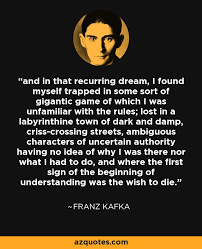
In the short story «A Dream» by Franz Kafka, a man dreams of his funeral after an actually planned walk. It is interesting that the first sentence is already «Josef K. dreamed» and thus, in contrast to many other short stories by Kafka, any doubts or argumentative thoughts about a dream parallel in favor of a dream are already superfluous at the beginning. What effect Kafka achieves with this story is to be presented with the help of this interpretation.
Joseph K. dreams that he wants to go for a walk on a beautiful day. Immediately he reaches a cemetery, where he tries to visit a burial mound spotted in the distance. This is made much more difficult for him, but he still reaches him. There, a tombstone of two men is fixed in the ground, a third is added and labels the tombstone. Intensely observed by K., it is difficult for him. Nevertheless, he can complete his work, while K. sinks into the grave and finally recognizes his own name on the tombstone. Delighted by that, K. wakes up.
The action just described has an arc of tension. Due to the initial failure to reach the burial mound, it acquires a special meaning and tension is stirred up. This is apparently dissolved by falling when the burial mound is reached, but then new tension is built up by the activities of the men and the artist, which intensifies to the end and is only dissolved with the last sentence. The not exaggerated tension build-up thus helps to understand the dramaturgy of the dream. Further tension is achieved by a short change of the tempus: The story is written in the imperfect, only the fact that the artist has to bend forward to reach the tombstone is partly written in the present tense, namely twice by using the word «must». The description of the stone directly in front of it and also the justification of its behavior are again in the imperfect. It is also the only two times that the one duty-expressing auxiliary verb «must» appears in the short story. So not only is tension created here by temporal direct reference to events, but also the oppression by continuous constraints in life is also hinted at, which will have an even greater meaning later in the story.
The short story is divided into four sections of unequal size. The first paragraph and thus the first mental section describes the discovery of the burial mound and the way there, the way to the cemetery is found here in the first place. The second paragraph describes the tombstone and its eposing, while the third paragraph describes the activity of the artist, his relationship with K. and ultimately the funeral. The fourth section, the last sentence, is directly related to the introductory sentence before the actual first paragraph. This framework describes that it is a dream and thus dissolves the story. In my opinion, however, the first sentence is unimportant in terms of enlightenment, as the last sentence already has enough dream explanatory effect. Kafka will nevertheless have used the first sentence in order to leave no doubt about the dream parallel of the content from the outset. However, this rather does not correspond to his typical style, only in positively outgoing stories such as «The Imperial Message» he uses this resolution, precisely to bring about a positive, liberating outcome despite the described desperate situation, filled with constraints.
Through the described introduction of the remaining plot in three sections, different reference objects and persons to K. are given a special importance. These are the burial mound, the tombstone, the artist, the pencil and the hole. The word «redemption» and the apparent cheering as a pre-announcement of those, which I will explain below, is also given great importance. As explained earlier, constraints of everyday life have a central importance in this short story. Here, however, it is not K. himself who suffers from the constraints, but the artist who has to prevent himself. The artist as the actual main actor in this scene, thus symbolizes for a short moment the constricted everyday person that Kafka usually represents. This will be brought in again later, when the artist seems to have lost his «liveliness».
It is paradoxical that the grave is prepared for K., but the artist is the constricted person. He discharges the compulsions in his anger through which we created the grave. By pounding, the earth flies up and a hole is dug. And it is precisely at this point that an exchange of roles takes place, which is only possible through the use of the authorial narrator: It is not clearly determined who digs in the earth and creates the hole. «He» can be transferred retroactivly to «him», i.e. the artist, and also to K. The action is thus transferred to K., leaving it open whether he will create his grave himself. The «redemption» that K. experiences when the artist continues to write, thus regains a meaning at this point, namely in the grave as salvation from the constraints. Even the «cheer», which only seems to exist, anticipates such an end. The golden letters thus also speak for a redemption, by the fact that the name is written pale after the hesitation, so ultimately «powerful ornaments» are emblazoned on the tombstone, the salvation is in turn represented as something wonderful that makes everything appear golden. The use of the pencil also speaks for the destitution of the individual, the gold at the beginning of failure for self-realization under such circumstances.
The typical of Kafka is thus almost lost, namely at the beginning the difficulty of the way to the burial mound, which is then suddenly there, something like the helplessness, the hopelessness in the scene, where K. and the artist look at each other and the writing plot rests. Nevertheless, the latter is of great importance, because ultimately this break and the break make the role exchange possible. Through the word «abzubitten» the funeral seems like a punishment, but the redemption from the constraints surpasses this.

In this respect, Kafka’s life path is reflected here. His father, plagued by work constraints, transfers his suffering to Kafka himself. Death, which thus brings the separation from the artist, stands for the separation from the father. But he is attached to his father, he still loves him, and thus death is the only possibility for a separation without Kafka himself having to suffer from it. A religious interpretation would be conceivable, but this does not appeal to me here due to its lack of character, but the autobiographical interpretation seems conclusive to me





